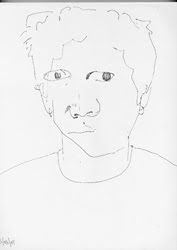Friday, April 13, 2012
2011 Kaminsky Annual Report
This is the 2011 Kaminsky Annual Report. An explanation follows the images but if you want more information on this odd project, feel free to comment or email me. high res pdf
This report is not a product unto itself but is the byproduct of a process of time management and record keeping that I use to guide the functional aspects of my creative life. It is physically based on a series of spreadsheets that I use daily to record the duration of various activities and to sort it into one of 16 different categories. It is psychically based on a notion of lateral temporal importance and compartmentalization that breaks a unit of time (hour/day/week/month/year) into smaller efficiency problems and strategies in order to spend more time doing things I enjoy and less time doing things I don’t. This system has grown organically over the past three years and is partially the result of trying to maintain an art practice and a day job, but is also an attempt to manage multiple, unrelated creative pursuits simultaneously. This absurd report is an overview of the past three years of record keeping.
It began when I first started renting a studio apart from my house. After a couple of months I had my doubts that I was using it enough to justify paying the extra rent. I had recently started keeping a financial budget and beginning to be able to control my spending through feedback. I decided to start clocking-in to the studio and setup a simple, three-column spreadsheet to record these hours. After several months of record keeping, I began to set a few weekly, then monthly goals. After three years I can say without a doubt that more analysis is needed. My art hours have consistently increased in each year whereas time spent playing music has decreased regularly over the same time. I monitor these spreadsheets daily.
Perhaps it is important to note that I have only set goals for two of the 16 time categories I track. It is important to live a balanced life and to have time in one’s day that is undifferentiated and aimless (other). There is a difference, though, between daydreaming or failed art-making time and inefficiently used time. Daydreaming and failure are as important to an art practice as physical making, so long as they are in balance with eachother. These are all useful ‘art’ hours. Inefficient time, however, is often time that is attempting to be something specific but can’t for any number of reasons. These could be because of poor planning, failing equipment, interruptions or an overwhelming desire to be elsewhere. Inefficient time can be eliminated to some degree through planning and a better under- standing of overall logistical-creative trends.
There are other personal reports like this in the world. The idea for this system and my annual report all grew organically from my own work but I have been influenced by other artists that I have discovered along the way who are working on similar projects, most notably Nicholas Felton and his Feltron Annual Report. He does this better than me and has been doing so for longer and discovering his report almost made me stop making mine. After some consideration, I have come to the conclusion that, while these are superfi- cially similar projects, we are working from substantially different motivations. Whereas his work is based around a strategy of measur- ing and compiling after the fact so as not to effect yearly life, I am primarily interested in using numbers to develop strategies to change the way I am living. This report is a document of that attempt. That said, I have stolen the idea of a beer list from him.
This approach to art making may seem rigid and ridiculous, counter to the notion of a free-flowing creative life. While it is extremely effective for allowing me to set and reach time-based goals in certain aspects of my daily activity, it is completely unable to evaluate the quality of time spent. I don’t see this as a problem for a number of reasons. First, I am poor at evaluating the quality of my work, not only for the reason that it is not my job but also because my good ideas might not always seem so good to me at first. The second, more functional reason is that the assumption behind this system that as long as I show up regularly, good things will happen. This notion is the basis for the chart on page one, which prioritizes regular, sustained engagement over short but more intense bursts of activity. This will be my model for 2012 activity, results will be included in next year’s report For all of these reasons, I have made an attempt to avoid including anything in this report that is value-based, with the exception of the discussions of my weekly/monthly goals.
Subscribe to:
Post Comments (Atom)

No comments:
Post a Comment